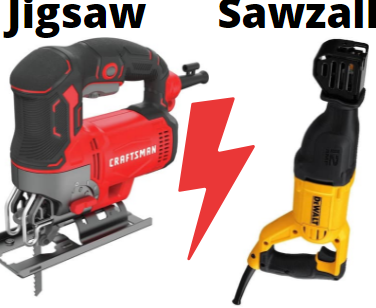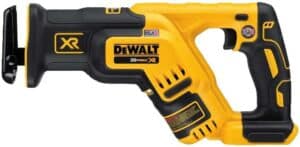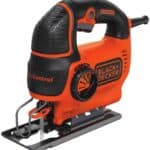
Both reciprocating saw and jigsaw are very useful and necessary tools for any DIY worker. These two tools have been used by woodworkers for decades and both are very widely used tools. We can do a wide range of works with these tools. Both reciprocating saw and jigsaw can cut various materials including wood, metal, ceramic, plastic, etc. These tools are very popular tools for home improvement projects. Both tools look quite similar. There blade also looks very similar.
But there is a lot of difference between these two tools and their use is also different. As we often need these tools for various home renovation projects, we need to know the difference between these tools. We need to know which tool is the best for which work. Otherwise, we won’t able to choose the right tool for our projects. So we need to know the proper use of these tools. In this article, we are largely going to talk about the differences and use of these tools.
Different between jigsaw vs reciprocating saw
Both jigsaw and reciprocating saw are power tools and can be used with various works. In fact, the jigsaw is one king of reciprocating saw.
Use of a Reciprocating Saw:

If you want a powerful tool for demolition, the reciprocating saw should be your go for the tool. Reciprocating saw is widely used for demolition work. It has a powerful motor and can cut very quickly various types of materials. Though it gives rough cuts and an easy and quick changeable blade system, great power makes it the ideal tool for demolition. You also can use it for cutting tree limbs and branches.
Pros:
- Great for demolition
- Fast and powerful
- Blade changing and use very easy
- Can cut almost any material
Cons:
- Not good for fine cut
- Not ideal for making complex and detail cut
Use of a Jigsaw:

Though jigsaw is one kind of reciprocating saw jigsaw is more ideal for complex and detailed works. It gives a very fine cut. Also, a jigsaw usually is not as powerful as a reciprocating saw. But jigsaw for making wooden carve, design, shape, and circle jigsaw is more accurate and ideal than a reciprocating saw. A reciprocating saw can give only rough cuts but a jigsaw can give a really fine cut. So for making any furniture there is no alternative to a jigsaw. You can make carve and circular with a reciprocating saw but usually it will be very rough.
Pros:
- Ideal for making complex and detail cut
- Ideal for fine cut
- Lightweight and easy to use
- Very useful for furniture work
Cons:
- Not ideal for demolition
- Cannot make very deep cut
- Not very powerful
Jigsaw vs reciprocating saw blade difference:
Jigsaw blade teeth are much narrowed and also fragile compare to the reciprocating saw blade. Also, the jigsaw blade is thinner than the reciprocating saw blade. That is why jigsaw cuts are finer than the reciprocating saw blade. There are different types of jigsaw blades to cut different types of materials. So, teeth per inch(TPI) and blade thickness vary from material to material.
On the other hand, the reciprocating saw blade is much more thick and strong than the jigsaw blade. Because reciprocating saw blade uses for demolition and fast cutting. So reciprocating saw blade needs to be stronger and thicker.
The major difference between jigsaw and reciprocating saw:
- Jigsaw is much lightweight than the reciprocating saw.
- Reciprocating saw is more powerful than the jigsaw
- Reciprocating saw mostly uses for demolition work and jigsaw uses for complex, detail and fine cut.
- Jigsaw blade is thin and flexible, the reciprocating saw blade is thick and strong
Final Recommendation
Finally, both jigsaw and reciprocating saw have their use and importance based on work. Both tools are extremely necessary and popular tools in woodwork and DIY worker. There is no winner between jigsaw and reciprocating saw. You should choose between jigsaw and reciprocating saw based on your work requirement.
Check the best tire cutting Sawzall blade
What are the best Sawzall blades for hardened steel?
What is an orbital jigsaw setting?
Last Updated on January 31, 2022 by John G. Anderson
Contents
